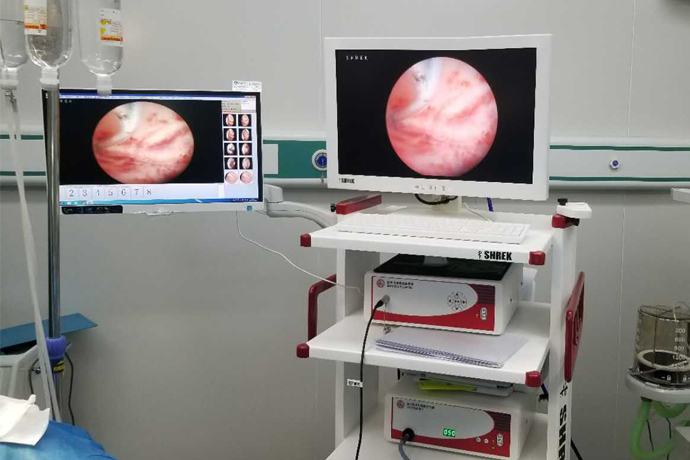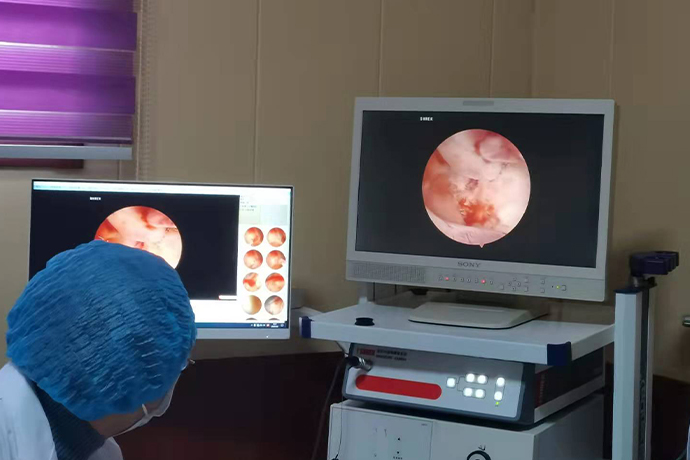【Ovology Laparoscopy】Hysteroscopy under hysteroscopic fallopian tube hysteroscopy
Release time: 11 Oct 2022 Author:Shrek
It is often seen clinically that the eggs and sperm are normal, and there are normal menstruation, but it is a patient who is not pregnant. In this case, think about uterine fallopian tube problems. Statistics show that infertility caused by tubal obstruction accounts for 30%-40% of all infertile patients.

The reasons for the occurrence of fallopian tube obstruction are often: intrauterine infection, abortion, etc., these inflammatory factors spread to the fallopian tube through the opening of the fallopian tube, and then local or whole fallopian tube obstruction occurs.
Hysteroscopic interventional dredging of fallopian tubes. Many years of trying to conceive without success, the reason is bilateral fallopian tube obstruction. Using hysteroscopic interventional dredging of the fallopian tubes, the patient was successfully dredged bilateral fallopian tubes. Opens up new avenues for infertility due to fallopian tube causes.
Common obstruction: tubal interstitial, tubal isthmus, tubal fimbriae obstruction. Obstruction leads to the inability of the egg and the sperm to meet, or after the encounter, the fertilized egg cannot return to the uterine cavity due to stenosis of the fallopian tube, and thus cannot be successfully conceived, or the fertilized egg is blocked in the process of passing through the fallopian tube due to stenosis of the fallopian tube after conception, resulting in an ectopic pregnancy requiring surgery Operation.
The fallopian tube is a road to fertility, but the obstruction closes the door for the egg and sperm to meet, so the fallopian tube must be unobstructed! The fertilized egg can be successfully reported to the uterus.
1. Hysteroscopic tubal intubation dredging:
Rigid hysteroscopy was used for examination. Methods: The patient was taken in the bladder lithotomy position, the depth and direction of the uterine cavity were detected with a probe, and the cervical canal was dilated to No. 7 (the outer diameter of the sheath was 6.5mm). 5% glucose solution was used as the uterine distention solution, and the hysteroscope was slowly placed. Check the uterine fundus, uterine horn and fallopian tube opening first, then the front, back, left and right walls of the harem body, and observe the cervical canal when exiting the hysteroscope.
In the process of examination, the intubation of the fallopian tube orifice is performed, that is, under direct vision, a medical plastic catheter with an outer diameter of 1.6 mm is inserted into the opening of the fallopian tube, and diluted methylene blue solution (with 80,000 units of gentamicin, dexamethasone, and dexamethasone) is used. Metasone 10mg) for fluid passage, the volume of fluid passage on each side is 40mL, and pressure injection is given to those who are blocked or blocked. The fluid flow was observed by hysteroscopy.
Results evaluation: no resistance and no backflow, or there is resistance, but the resistance disappears after pressurized injection, the fallopian tube is unobstructed. There is a certain resistance, there is still resistance after pressurized injection, or the resistance is large, and the resistance is relieved after pressurized injection but does not disappear, the fallopian tube is blocked. If the resistance is large, and the resistance is still large after pressure injection, the fallopian tube is blocked. If the fallopian tubes are unobstructed or blocked, the resistance of the flow through the fluid is judged, and there is no backflow.
Methylene blue liquid bolus injection, feel whether there is resistance, observe whether there is reflux under hysteroscopy, if there is no resistance and no reflux, it indicates that the fallopian tubes are unobstructed.
If there is resistance and no regurgitation, it indicates that the fallopian tube is not smooth; if there is resistance and there is reflux, it indicates that the fallopian tube may be blocked.
The inner diameter of the proximal 4-5 cm of the fallopian tube is only 1 mm or less, and it is easy to form adhesions or blockages due to inflammation or endometrial fragments. When performing hysteroscopic intubation of the fallopian tube orifice, the syringe can directly inject the liquid into the fallopian tube with a pressure several times or even ten times greater than the traditional fallopian tube, so that the fallopian tube is partially adhered and mild to moderate. The obstruction can be separated and dredged, so that the cases of tubal patency after operation are significantly increased compared with those before operation.
The traditional method of passing fluid through the fallopian tubes relies only on drug injection resistance for judgment, which is both blind and unreliable, and the treatment effect is poor. Generally, it is only suitable for minor adhesions, and cannot be unblocked for heavier adhesions, twists, and blockages. Laparoscopic tubal catheterization is effective only for pelvic adhesions and obstruction of the distal end of the fallopian tube. When intubating the fallopian tube orifice under hysteroscopy, the catheter is directly inserted into the interstitial part of the fallopian tube, and the pressure of the syringe is several times or even dozens of times larger than that of the traditional intubation, so that the fallopian tube cavity is partially adhered or light, moderate The degree of obstruction can be separated and unclogged. However, if the obstruction site is only hole-like dredging, the obstruction is not completely opened, and the fertilized egg transport function is affected. To solve this problem, the combined treatment of hysteroscopy and laparoscopy is more effective.
2. The advantages of hysteroscopic tubal interventional dredging:
Under hysteroscopy, the opening of both fallopian tubes can be truly seen. A guide wire as thin as a hair (0.38mm) is used to dredge the fallopian tubes, and then drugs to prevent inflammation and edema of the fallopian tubes are injected.
In hysteroscopic tubal dredging, inflammatory tissue hyperplasia at the opening of the fallopian tube can be seen, requiring catheters and guide wires to dredge.
Hysteroscopic intubation in the treatment of fallopian tube obstruction has the following advantages:
(1) Operation under direct vision, with high accuracy.
(2) The pressure in the fallopian tube lumen is high, and the treatment effect on the proximal end of the fallopian tube or the adhesion of the fallopian tube lumen is good, and the adhesion is easy to be washed away.
(3) Other intrauterine lesions that cause infertility can also be found.
3. Precautions for hysteroscopic tubal dredging:
1. Observe vital signs, anti-infective treatment.
2. Strenuous exercise, bathing, heavy physical labor, and intercourse can only be performed 1 month after the operation. Respect the doctor's orders for medication.
3. Follow-up for abnormal conditions such as abdominal pain and fever after operation.
4. The second month after the operation is evaluated by the doctor. If the recovery is good, it is recommended to prepare for pregnancy as soon as possible. If the recanalization fails, it is recommended to transfer to the reproductive department for assisted reproduction, that is, test tube baby.
5. Taking traditional Chinese medicine for promoting blood circulation and removing blood stasis and dredging collaterals can maintain tubal recanalization for a long time after operation and increase the pregnancy rate.

- Recommended news
- 【General Surgery Laparoscopy】Cholecystectomy
- Surgery Steps of Hysteroscopy for Intrauterine Adhesion
- [Gynecological Hysteroscopy] Techniques for Preventing and Treating Complications of Hysteroscopic Surgery
- [Gynecological Hysteroscopy] Hysteroscopic Adhesiolysis
- [Gynecological Hysteroscopy] IUD Removal under Hysteroscopy